Analysis of HEAL Program: Promoting Community Well-being
VerifiedAdded on 2023/04/21
|6
|1517
|237
Report
AI Summary
This report provides an analysis of the Healthy Eating and Active Living (HEAL) program implemented in the Washington community, aimed at promoting healthy practices and combating obesity and diabetes. The report details the structure and governance of the HEAL program, including its program team and national implementation group, emphasizing its focus on healthy weight management and active living. It highlights the program's contributions to the overall health of the community, such as encouraging healthy eating habits, promoting physical activity, and providing community education on health issues. The report also discusses the program's partnerships with other healthcare agencies and interdisciplinary professionals to provide comprehensive services, including health checkup camps and Medicaid facilities. Statistical data on the reduction of diabetes rates and obesity trends among children are presented to assess the program's effectiveness. The conclusion summarizes the program's objectives and its focus on transforming families into informed community members with healthy lifestyles.
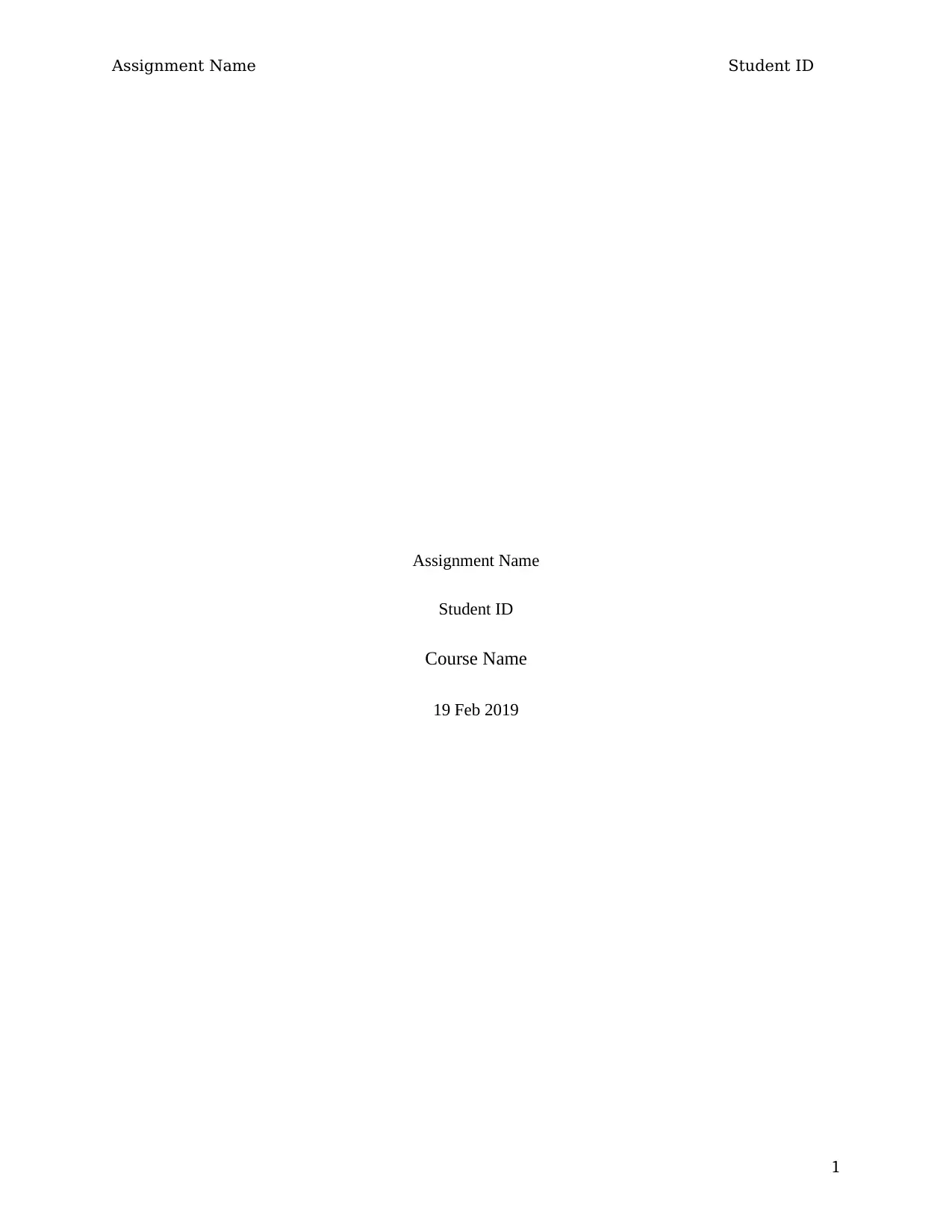
Assignment Name Student ID
Assignment Name
Student ID
Course Name
19 Feb 2019
1
Assignment Name
Student ID
Course Name
19 Feb 2019
1
Paraphrase This Document
Need a fresh take? Get an instant paraphrase of this document with our AI Paraphraser
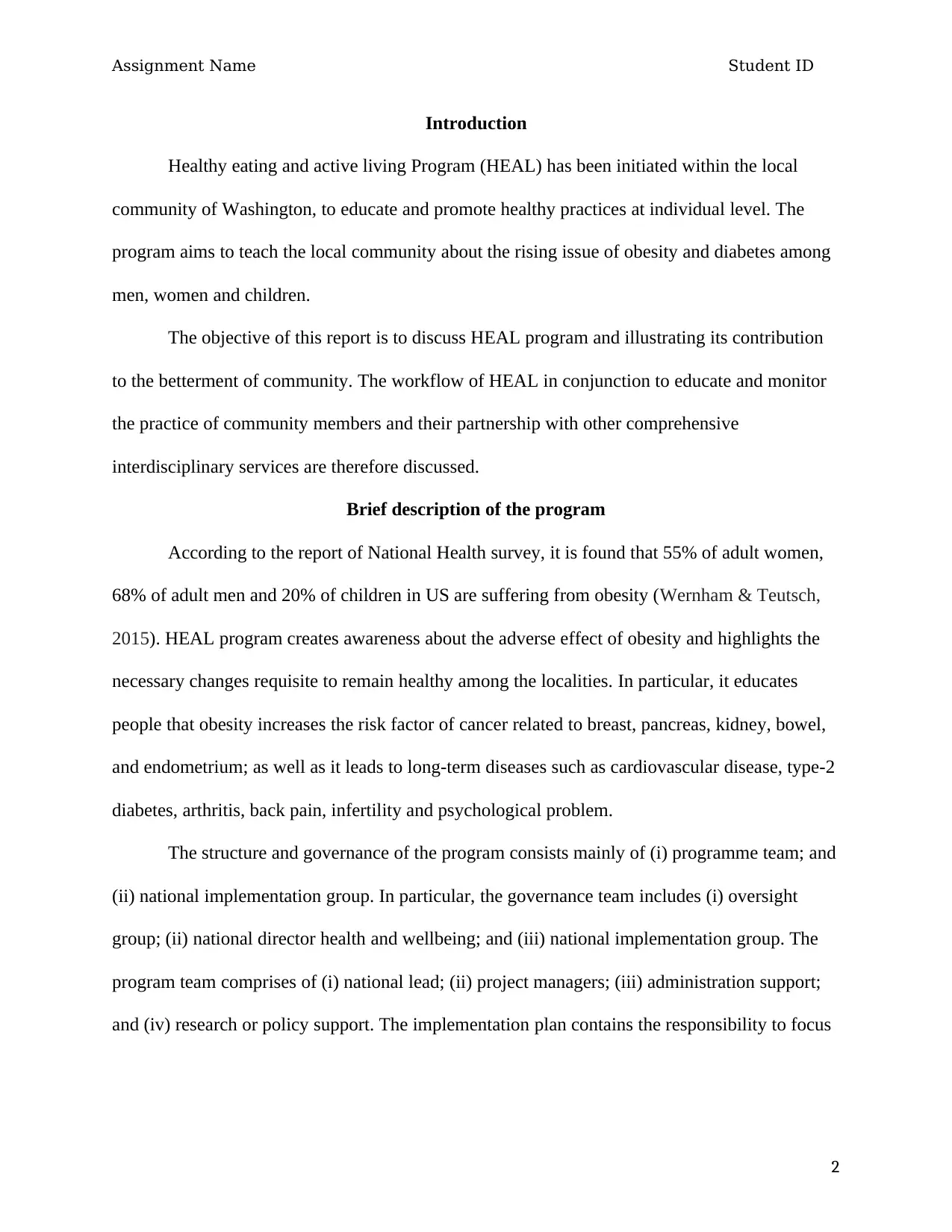
Assignment Name Student ID
Introduction
Healthy eating and active living Program (HEAL) has been initiated within the local
community of Washington, to educate and promote healthy practices at individual level. The
program aims to teach the local community about the rising issue of obesity and diabetes among
men, women and children.
The objective of this report is to discuss HEAL program and illustrating its contribution
to the betterment of community. The workflow of HEAL in conjunction to educate and monitor
the practice of community members and their partnership with other comprehensive
interdisciplinary services are therefore discussed.
Brief description of the program
According to the report of National Health survey, it is found that 55% of adult women,
68% of adult men and 20% of children in US are suffering from obesity (Wernham & Teutsch,
2015). HEAL program creates awareness about the adverse effect of obesity and highlights the
necessary changes requisite to remain healthy among the localities. In particular, it educates
people that obesity increases the risk factor of cancer related to breast, pancreas, kidney, bowel,
and endometrium; as well as it leads to long-term diseases such as cardiovascular disease, type-2
diabetes, arthritis, back pain, infertility and psychological problem.
The structure and governance of the program consists mainly of (i) programme team; and
(ii) national implementation group. In particular, the governance team includes (i) oversight
group; (ii) national director health and wellbeing; and (iii) national implementation group. The
program team comprises of (i) national lead; (ii) project managers; (iii) administration support;
and (iv) research or policy support. The implementation plan contains the responsibility to focus
2
Introduction
Healthy eating and active living Program (HEAL) has been initiated within the local
community of Washington, to educate and promote healthy practices at individual level. The
program aims to teach the local community about the rising issue of obesity and diabetes among
men, women and children.
The objective of this report is to discuss HEAL program and illustrating its contribution
to the betterment of community. The workflow of HEAL in conjunction to educate and monitor
the practice of community members and their partnership with other comprehensive
interdisciplinary services are therefore discussed.
Brief description of the program
According to the report of National Health survey, it is found that 55% of adult women,
68% of adult men and 20% of children in US are suffering from obesity (Wernham & Teutsch,
2015). HEAL program creates awareness about the adverse effect of obesity and highlights the
necessary changes requisite to remain healthy among the localities. In particular, it educates
people that obesity increases the risk factor of cancer related to breast, pancreas, kidney, bowel,
and endometrium; as well as it leads to long-term diseases such as cardiovascular disease, type-2
diabetes, arthritis, back pain, infertility and psychological problem.
The structure and governance of the program consists mainly of (i) programme team; and
(ii) national implementation group. In particular, the governance team includes (i) oversight
group; (ii) national director health and wellbeing; and (iii) national implementation group. The
program team comprises of (i) national lead; (ii) project managers; (iii) administration support;
and (iv) research or policy support. The implementation plan contains the responsibility to focus
2
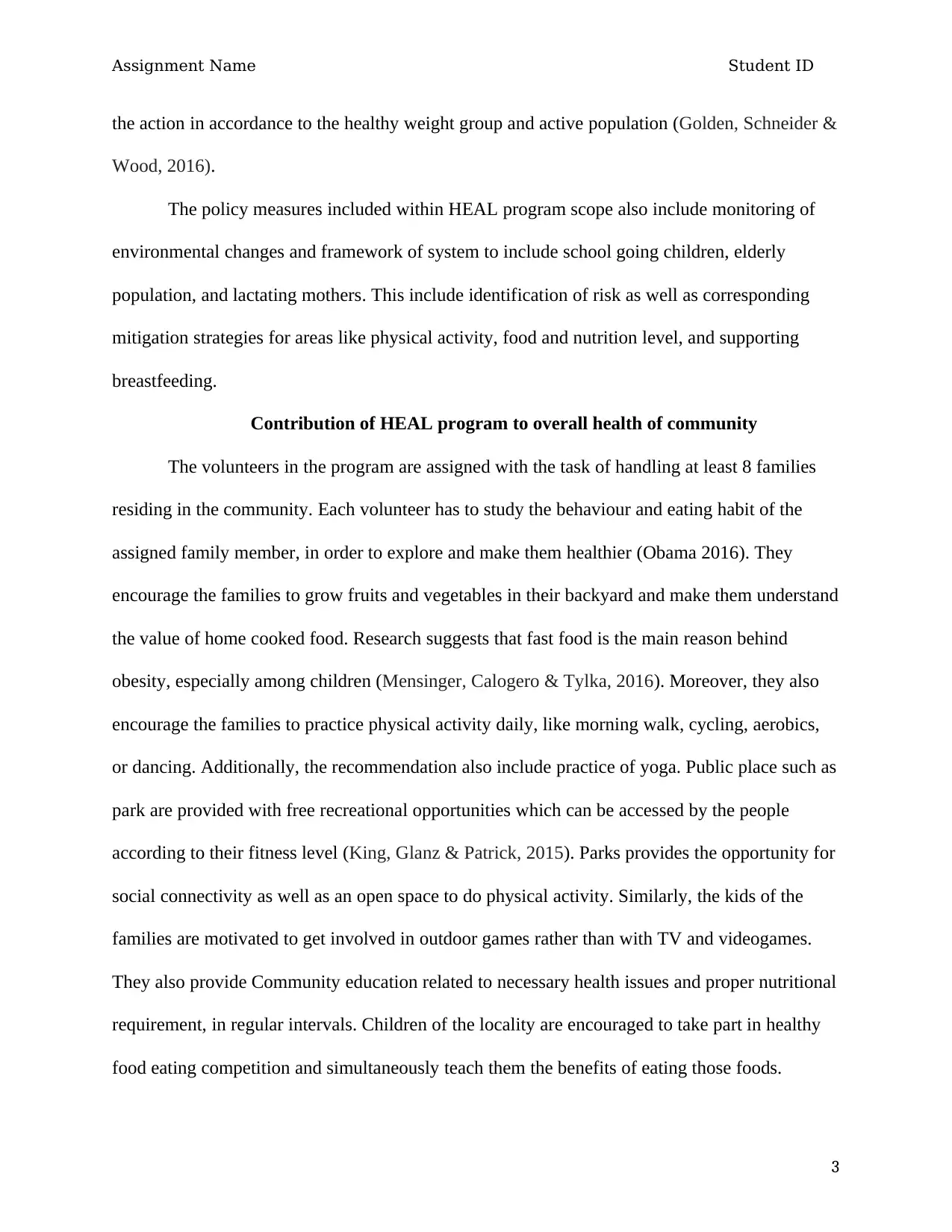
Assignment Name Student ID
the action in accordance to the healthy weight group and active population (Golden, Schneider &
Wood, 2016).
The policy measures included within HEAL program scope also include monitoring of
environmental changes and framework of system to include school going children, elderly
population, and lactating mothers. This include identification of risk as well as corresponding
mitigation strategies for areas like physical activity, food and nutrition level, and supporting
breastfeeding.
Contribution of HEAL program to overall health of community
The volunteers in the program are assigned with the task of handling at least 8 families
residing in the community. Each volunteer has to study the behaviour and eating habit of the
assigned family member, in order to explore and make them healthier (Obama 2016). They
encourage the families to grow fruits and vegetables in their backyard and make them understand
the value of home cooked food. Research suggests that fast food is the main reason behind
obesity, especially among children (Mensinger, Calogero & Tylka, 2016). Moreover, they also
encourage the families to practice physical activity daily, like morning walk, cycling, aerobics,
or dancing. Additionally, the recommendation also include practice of yoga. Public place such as
park are provided with free recreational opportunities which can be accessed by the people
according to their fitness level (King, Glanz & Patrick, 2015). Parks provides the opportunity for
social connectivity as well as an open space to do physical activity. Similarly, the kids of the
families are motivated to get involved in outdoor games rather than with TV and videogames.
They also provide Community education related to necessary health issues and proper nutritional
requirement, in regular intervals. Children of the locality are encouraged to take part in healthy
food eating competition and simultaneously teach them the benefits of eating those foods.
3
the action in accordance to the healthy weight group and active population (Golden, Schneider &
Wood, 2016).
The policy measures included within HEAL program scope also include monitoring of
environmental changes and framework of system to include school going children, elderly
population, and lactating mothers. This include identification of risk as well as corresponding
mitigation strategies for areas like physical activity, food and nutrition level, and supporting
breastfeeding.
Contribution of HEAL program to overall health of community
The volunteers in the program are assigned with the task of handling at least 8 families
residing in the community. Each volunteer has to study the behaviour and eating habit of the
assigned family member, in order to explore and make them healthier (Obama 2016). They
encourage the families to grow fruits and vegetables in their backyard and make them understand
the value of home cooked food. Research suggests that fast food is the main reason behind
obesity, especially among children (Mensinger, Calogero & Tylka, 2016). Moreover, they also
encourage the families to practice physical activity daily, like morning walk, cycling, aerobics,
or dancing. Additionally, the recommendation also include practice of yoga. Public place such as
park are provided with free recreational opportunities which can be accessed by the people
according to their fitness level (King, Glanz & Patrick, 2015). Parks provides the opportunity for
social connectivity as well as an open space to do physical activity. Similarly, the kids of the
families are motivated to get involved in outdoor games rather than with TV and videogames.
They also provide Community education related to necessary health issues and proper nutritional
requirement, in regular intervals. Children of the locality are encouraged to take part in healthy
food eating competition and simultaneously teach them the benefits of eating those foods.
3
⊘ This is a preview!⊘
Do you want full access?
Subscribe today to unlock all pages.

Trusted by 1+ million students worldwide
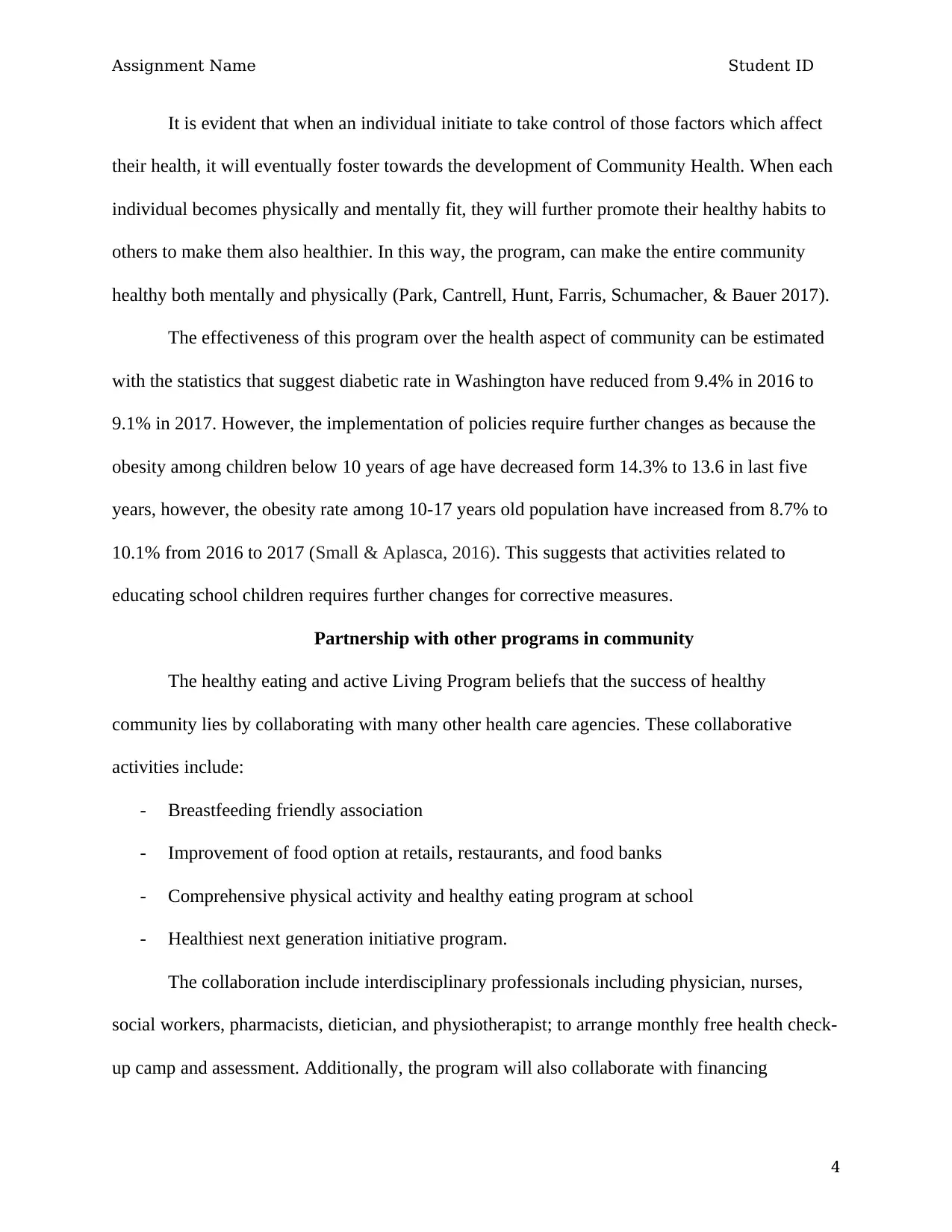
Assignment Name Student ID
It is evident that when an individual initiate to take control of those factors which affect
their health, it will eventually foster towards the development of Community Health. When each
individual becomes physically and mentally fit, they will further promote their healthy habits to
others to make them also healthier. In this way, the program, can make the entire community
healthy both mentally and physically (Park, Cantrell, Hunt, Farris, Schumacher, & Bauer 2017).
The effectiveness of this program over the health aspect of community can be estimated
with the statistics that suggest diabetic rate in Washington have reduced from 9.4% in 2016 to
9.1% in 2017. However, the implementation of policies require further changes as because the
obesity among children below 10 years of age have decreased form 14.3% to 13.6 in last five
years, however, the obesity rate among 10-17 years old population have increased from 8.7% to
10.1% from 2016 to 2017 (Small & Aplasca, 2016). This suggests that activities related to
educating school children requires further changes for corrective measures.
Partnership with other programs in community
The healthy eating and active Living Program beliefs that the success of healthy
community lies by collaborating with many other health care agencies. These collaborative
activities include:
- Breastfeeding friendly association
- Improvement of food option at retails, restaurants, and food banks
- Comprehensive physical activity and healthy eating program at school
- Healthiest next generation initiative program.
The collaboration include interdisciplinary professionals including physician, nurses,
social workers, pharmacists, dietician, and physiotherapist; to arrange monthly free health check-
up camp and assessment. Additionally, the program will also collaborate with financing
4
It is evident that when an individual initiate to take control of those factors which affect
their health, it will eventually foster towards the development of Community Health. When each
individual becomes physically and mentally fit, they will further promote their healthy habits to
others to make them also healthier. In this way, the program, can make the entire community
healthy both mentally and physically (Park, Cantrell, Hunt, Farris, Schumacher, & Bauer 2017).
The effectiveness of this program over the health aspect of community can be estimated
with the statistics that suggest diabetic rate in Washington have reduced from 9.4% in 2016 to
9.1% in 2017. However, the implementation of policies require further changes as because the
obesity among children below 10 years of age have decreased form 14.3% to 13.6 in last five
years, however, the obesity rate among 10-17 years old population have increased from 8.7% to
10.1% from 2016 to 2017 (Small & Aplasca, 2016). This suggests that activities related to
educating school children requires further changes for corrective measures.
Partnership with other programs in community
The healthy eating and active Living Program beliefs that the success of healthy
community lies by collaborating with many other health care agencies. These collaborative
activities include:
- Breastfeeding friendly association
- Improvement of food option at retails, restaurants, and food banks
- Comprehensive physical activity and healthy eating program at school
- Healthiest next generation initiative program.
The collaboration include interdisciplinary professionals including physician, nurses,
social workers, pharmacists, dietician, and physiotherapist; to arrange monthly free health check-
up camp and assessment. Additionally, the program will also collaborate with financing
4
Paraphrase This Document
Need a fresh take? Get an instant paraphrase of this document with our AI Paraphraser
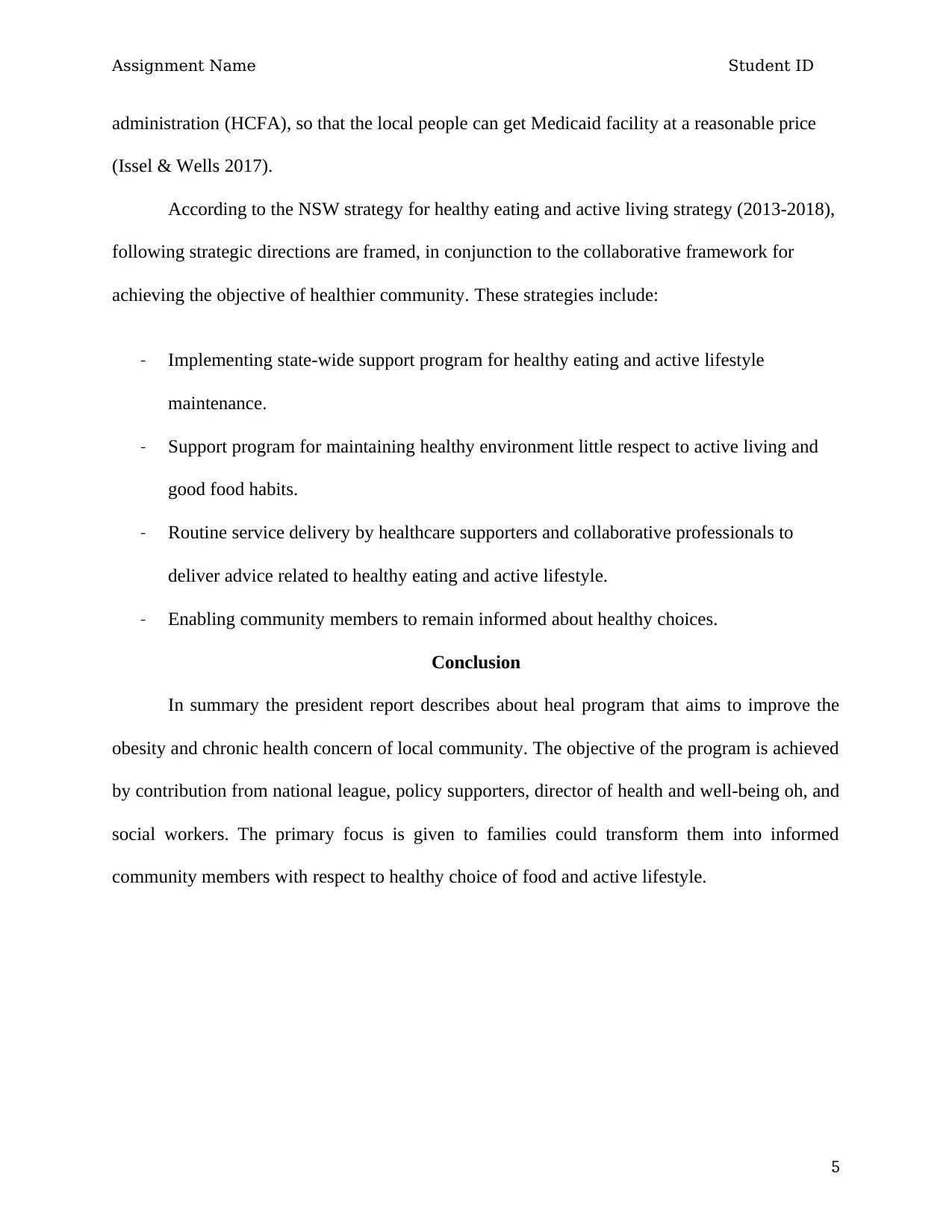
Assignment Name Student ID
administration (HCFA), so that the local people can get Medicaid facility at a reasonable price
(Issel & Wells 2017).
According to the NSW strategy for healthy eating and active living strategy (2013-2018),
following strategic directions are framed, in conjunction to the collaborative framework for
achieving the objective of healthier community. These strategies include:
- Implementing state-wide support program for healthy eating and active lifestyle
maintenance.
- Support program for maintaining healthy environment little respect to active living and
good food habits.
- Routine service delivery by healthcare supporters and collaborative professionals to
deliver advice related to healthy eating and active lifestyle.
- Enabling community members to remain informed about healthy choices.
Conclusion
In summary the president report describes about heal program that aims to improve the
obesity and chronic health concern of local community. The objective of the program is achieved
by contribution from national league, policy supporters, director of health and well-being oh, and
social workers. The primary focus is given to families could transform them into informed
community members with respect to healthy choice of food and active lifestyle.
5
administration (HCFA), so that the local people can get Medicaid facility at a reasonable price
(Issel & Wells 2017).
According to the NSW strategy for healthy eating and active living strategy (2013-2018),
following strategic directions are framed, in conjunction to the collaborative framework for
achieving the objective of healthier community. These strategies include:
- Implementing state-wide support program for healthy eating and active lifestyle
maintenance.
- Support program for maintaining healthy environment little respect to active living and
good food habits.
- Routine service delivery by healthcare supporters and collaborative professionals to
deliver advice related to healthy eating and active lifestyle.
- Enabling community members to remain informed about healthy choices.
Conclusion
In summary the president report describes about heal program that aims to improve the
obesity and chronic health concern of local community. The objective of the program is achieved
by contribution from national league, policy supporters, director of health and well-being oh, and
social workers. The primary focus is given to families could transform them into informed
community members with respect to healthy choice of food and active lifestyle.
5
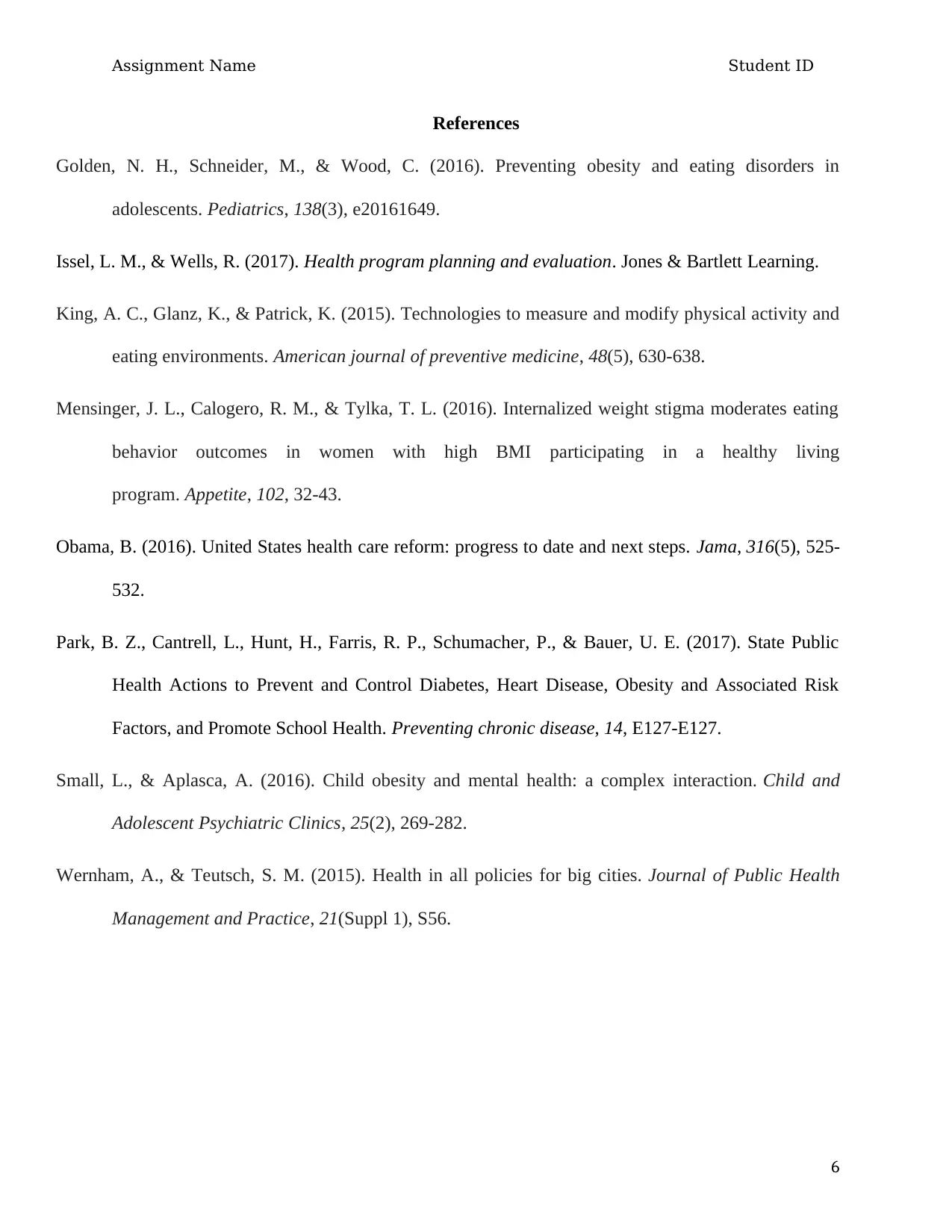
Assignment Name Student ID
References
Golden, N. H., Schneider, M., & Wood, C. (2016). Preventing obesity and eating disorders in
adolescents. Pediatrics, 138(3), e20161649.
Issel, L. M., & Wells, R. (2017). Health program planning and evaluation. Jones & Bartlett Learning.
King, A. C., Glanz, K., & Patrick, K. (2015). Technologies to measure and modify physical activity and
eating environments. American journal of preventive medicine, 48(5), 630-638.
Mensinger, J. L., Calogero, R. M., & Tylka, T. L. (2016). Internalized weight stigma moderates eating
behavior outcomes in women with high BMI participating in a healthy living
program. Appetite, 102, 32-43.
Obama, B. (2016). United States health care reform: progress to date and next steps. Jama, 316(5), 525-
532.
Park, B. Z., Cantrell, L., Hunt, H., Farris, R. P., Schumacher, P., & Bauer, U. E. (2017). State Public
Health Actions to Prevent and Control Diabetes, Heart Disease, Obesity and Associated Risk
Factors, and Promote School Health. Preventing chronic disease, 14, E127-E127.
Small, L., & Aplasca, A. (2016). Child obesity and mental health: a complex interaction. Child and
Adolescent Psychiatric Clinics, 25(2), 269-282.
Wernham, A., & Teutsch, S. M. (2015). Health in all policies for big cities. Journal of Public Health
Management and Practice, 21(Suppl 1), S56.
6
References
Golden, N. H., Schneider, M., & Wood, C. (2016). Preventing obesity and eating disorders in
adolescents. Pediatrics, 138(3), e20161649.
Issel, L. M., & Wells, R. (2017). Health program planning and evaluation. Jones & Bartlett Learning.
King, A. C., Glanz, K., & Patrick, K. (2015). Technologies to measure and modify physical activity and
eating environments. American journal of preventive medicine, 48(5), 630-638.
Mensinger, J. L., Calogero, R. M., & Tylka, T. L. (2016). Internalized weight stigma moderates eating
behavior outcomes in women with high BMI participating in a healthy living
program. Appetite, 102, 32-43.
Obama, B. (2016). United States health care reform: progress to date and next steps. Jama, 316(5), 525-
532.
Park, B. Z., Cantrell, L., Hunt, H., Farris, R. P., Schumacher, P., & Bauer, U. E. (2017). State Public
Health Actions to Prevent and Control Diabetes, Heart Disease, Obesity and Associated Risk
Factors, and Promote School Health. Preventing chronic disease, 14, E127-E127.
Small, L., & Aplasca, A. (2016). Child obesity and mental health: a complex interaction. Child and
Adolescent Psychiatric Clinics, 25(2), 269-282.
Wernham, A., & Teutsch, S. M. (2015). Health in all policies for big cities. Journal of Public Health
Management and Practice, 21(Suppl 1), S56.
6
⊘ This is a preview!⊘
Do you want full access?
Subscribe today to unlock all pages.

Trusted by 1+ million students worldwide
1 out of 6
Related Documents
Your All-in-One AI-Powered Toolkit for Academic Success.
+13062052269
info@desklib.com
Available 24*7 on WhatsApp / Email
![[object Object]](/_next/static/media/star-bottom.7253800d.svg)
Unlock your academic potential
Copyright © 2020–2025 A2Z Services. All Rights Reserved. Developed and managed by ZUCOL.





